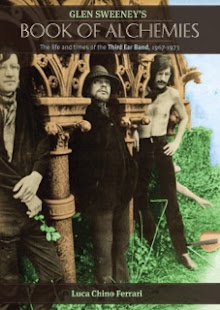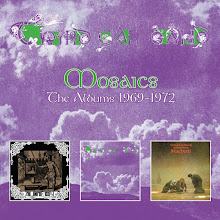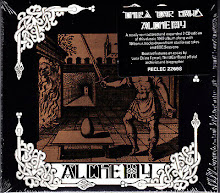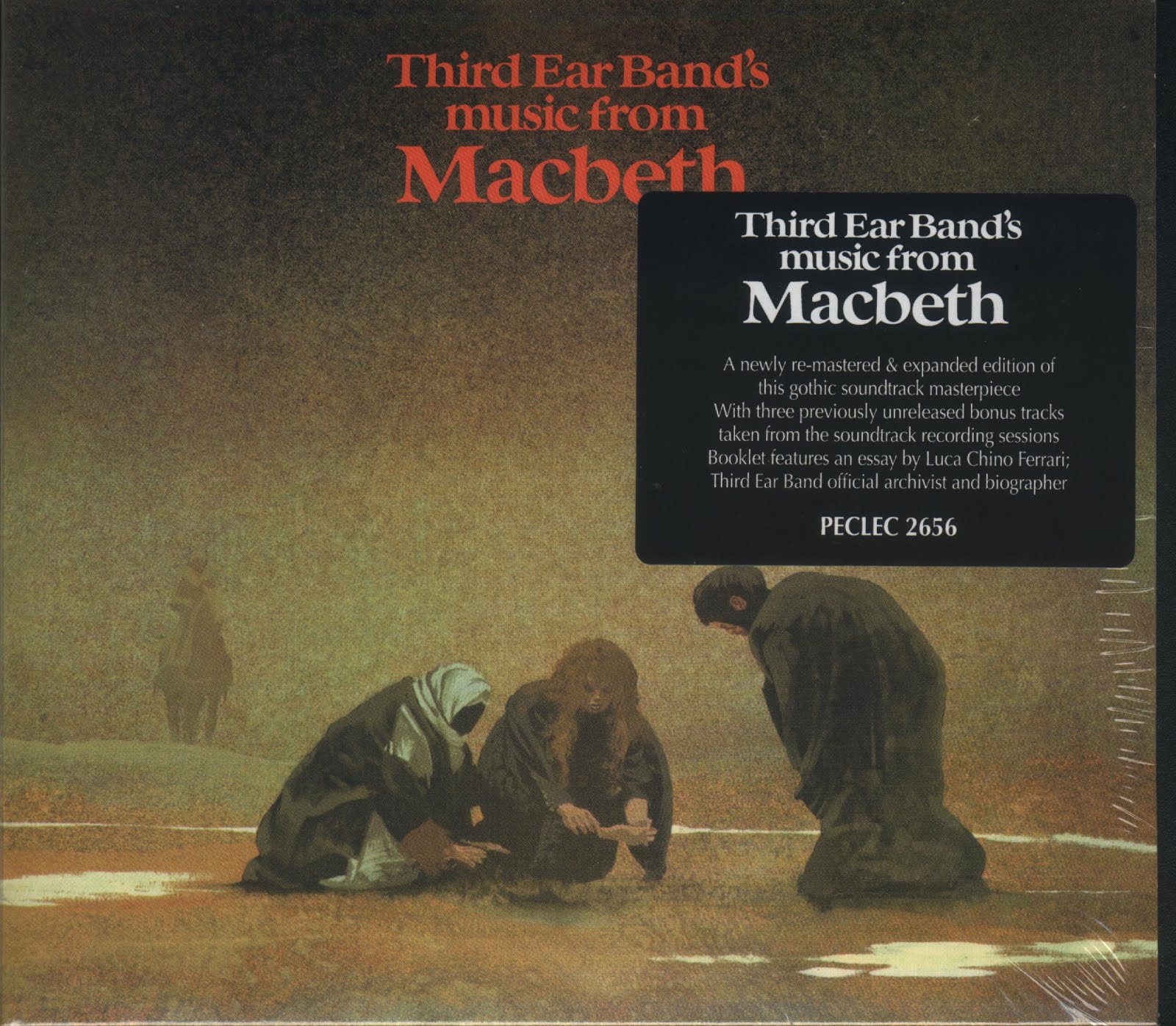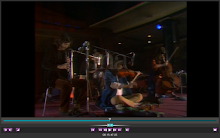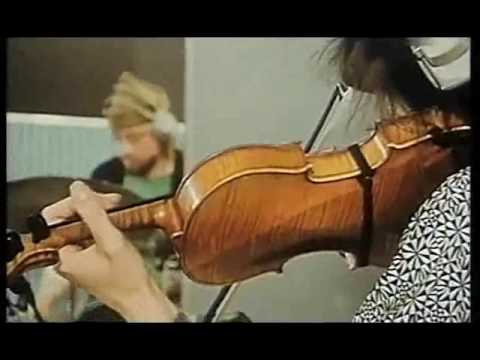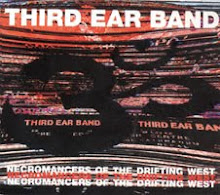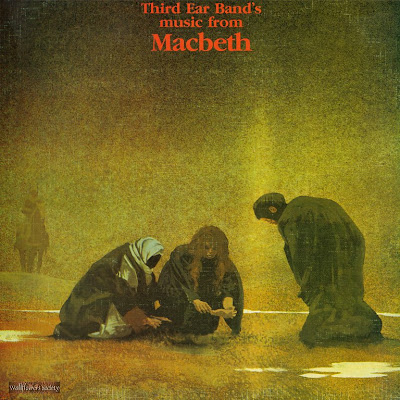As we know, at the beginning of its story, TEB used to have posters/flyers/covers with right references of the alchemical tradition adopting old obscure engraves as iconography. This is a brief look at the known TEB's alchemical references with some notes about origins and meanings...

One of the first TEB posters designed by Glen Sweeney in 1968-69 using the original engrave taken from "Cabala" by S. Michelspacher (1616). Glen wrote the motto Time travel is the alchemic Third Ear Band. About the meanings of it: the main character on front right is the alchemist who is wandering (blindfolded) until the rabbit (just as in "Alice in Wonderland"!) shows him the right way to the Opus Magnum: a palace at the top of seven stairs, indicating the seven steps of alchemic process.
At the corners of the engrave, the fourth elements written in Latin. At the top of palace's roof (with sun and moon on it) a phoenix symbolizing the "philosophic mercury". All around signs of the zodiac indicate the alchemic work will start on May (under the Taurus).
 |
| "Cabala" by S. Michelspacher (1616) |

On this sketch of flyer probably designed by Sweeney note inside the tondo (a turned up egg) a picture reproducing an engrave taken from "Viatorum spagyricum" by Heinrich Jamsthaler (1625). The old engrave represents the alchemic First Materia with an hermarodite character (sun on left, moon on right) - with the Latin word "Rebis" (thing-two), the union of two principles, man & female, gold and silver - and a dragon, for Michael Meier "the fixed and volatile mercury" ("Atalanta Fugiens", 1617). In the alchemic tradition just the hermafrodite can defeat the beast. Infact sun and moon, together, can beat the "mercurial dragon": to kill him, in the alchemic practice, the alchemist have to extract the sulphur and lunar umidity ("Aurora consurgens", XVI century).
 |
| "Viatorum spagyricum" by Heinrich Jamsthaler (1625) |
Apart the main picture, taken from "Atalanta fugiens" edited by Michael Meier in 1617, an important role in the picture is held by the four snakes at the corners, just around the border of front and back cover. As Sweeney told during an old interview to I.T. magazine (issue 63, August 29th, 1969), “those serpents on the cover are completely magic – they are in a protected circle, they protect the whole album and the music on it”.
Infact, in some ancient traditions the snake "are represented as potent guardians of temples and other sacred spaces. This connection may be grounded in the observation that when threatened, some snakes (such as rattlesnakes or cobras) frequently hold and defend their ground, first resorting to threatening display and then fighting, rather than retreat. Thus, they are natural guardians of treasures or sacred sites which cannot easily be moved out of harm's way. At Angkor in Cambodia, numerous stone sculptures present hooded multi-headed nagas as guardians of temples or other premises. A favorite motif of Angkorean sculptors from approximately the 12th century A.D. onward was that of the Buddha, sitting in the position of meditation, his weight supported by the coils of a multi-headed naga that also uses its flared hood to shield him from above. This motif recalls the story of the Buddha and the serpent king Mucalinda: as the Buddha sat beneath a tree engrossed in meditation, Mucalinda came up from the roots of the tree to shield the Buddha from a tempest that was just beginning to arise." (http://en.wikipedia.org/wiki/Serpent_%28symbolism%29).
 |
| Original EMI advert for the album (1969) |
 |
| The original engrave from Meier's "Atalanta fugiens" (1617) |
Also the back cover was designed by David Loxley from a book edited in 1718 by J. C. Barchusen titled "Elementa chemicae": Sun (sulphur) and Moon (mercury) - male and female - are two basic elements of the alchemic process (read also at http://www.labyrinthdesigners.org/alchemy-religious-art/sun-moon-at-the-turn-of-the-first-millennium/). In his ancient alchemic manual Barchusen described the sequence to get the Philosophic Stone through two different ways: one short, so-called "dry"; the other long, so-called "damp".
Original "Alchemy" back cover (1969)
"Alchemically speaking, the moon represents Silver, the Lesser Work, or Mercury. It conjoins with the sun, or Gold in the Greater Work. In more practical terms, the moon represents fertility, resurrection, occult power, immortality and intuition. The moon is a feminine property and alchemists would incorporate it with the sun (gold) to assure balance" (from http://www.whats-your-sign.com/ancient-alchemy-symbols.html).
About the sun, it is considered "the ancient alchemy symbol of gold. Worshipped in many cultures, specifically Egypt where Amon-Ra was personified by the evening sun setting at the end of the creative process. Alchemists understood the process of creation, and utilized the symbol of the sun to focus on creating desired effects in their practice – both physically and philosophically".
 |
| The original engrave from "Elementa chemicae" (1718) |
On this 1969 poster the picture above on it was drawned probably by Sweeney from the engrave below, taken from "Viridarium chymicum" by D. Stolcius (Frankfurt 1624).
The four women represent the four elements: from left - earth, water, air and fire - and to the four steps of the Great Opera (the alchemic opera): under their foot the four grades of fire.
Note the reference to the "Alchemical exhalations" on the top, maybe alluding to the Aristotle's "Meteorology" - where the "dry" and "moist" exhalations of Aristotle become the (alchemical) sulphur and mercury of the eighth-century Islamic alchemists - and the clear reference to the classic dualism sun-moon... Note also the women breasts wryly designed by Sweeney just covered on the original engrave.
 |
| Viridarium chymicum" by D. Stolcius (Frankfurt 1624) |
About the engrave below (made by Hans Weiditz c. 1520), it shows the classic room of the alchemist at work with all his tools.
 |
"An Alchemist" by Hans
Weiditz (c. 1520)
|
When I edited the live tape recorded on January 11th, 1989 in Sarzana (Italy), titled "New forecasts from the Third Ear Almanac", I proposed to Glen to use a little work made in 1986 by Italian artist Mario Balestrieri: a simple, evocative reference to the sun-moon alchemic tradition...
Regarding the last TEB records published by Voiceprint in '80's and 90's, manteining the alchemic iconography tradition better than the records produced by Materiali Sonori, they was designed by Carolyn Looker, Sweeney's missus.
 |
| "Raga live" (Turning Point 2002) |
She used the Aegypto-Greek iconography of the snake eating itself (Ouroborus) symbolizing the cyclic time, the One in All, the Eternal Return, cyclic nature of things…
"It is believed to have been inspired by the Milky Way, as some ancient texts refer to a serpent of light residing in the heavens. The Ancient Egyptians associated it with Wadjet, one of their oldest deities as well as another aspect, Hathor. In Norse mythology the World Serpent (or Midgard serpent) known as Jormungandr encircled the world in the ocean's abyss biting its own tail" (http://en.wikipedia.org/wiki/Serpent_%28symbolism%29).
Here and below, Carolyn put inside the snake also pyramids, Sphynx and a flying U.F.O....
 |
| "Live" (Voiceprint 1996) |

On the cover below we have a variation of the snake's theme, also very common into alchemic iconography, with sun and moon with a snake. Note the design of them, just in the old alchemic tradition...
 |
| "Radio Session" (Voiceprint 1994) |
 |
| From "Elementa chemicae" by J. C. Barchusen (1718) |
Bibliographic note
A wonderful visual book about alchemic and hermetic symbols and iconography, partially used for this article, is "Alchemy & Mystic" by Alexander Roob (Taschen Verlag 1997, Italian edition 2011).
http://www.taschen.com
no©2012 Luca Ferrari (unless you intend to make a profit. In which case, ask first)












































